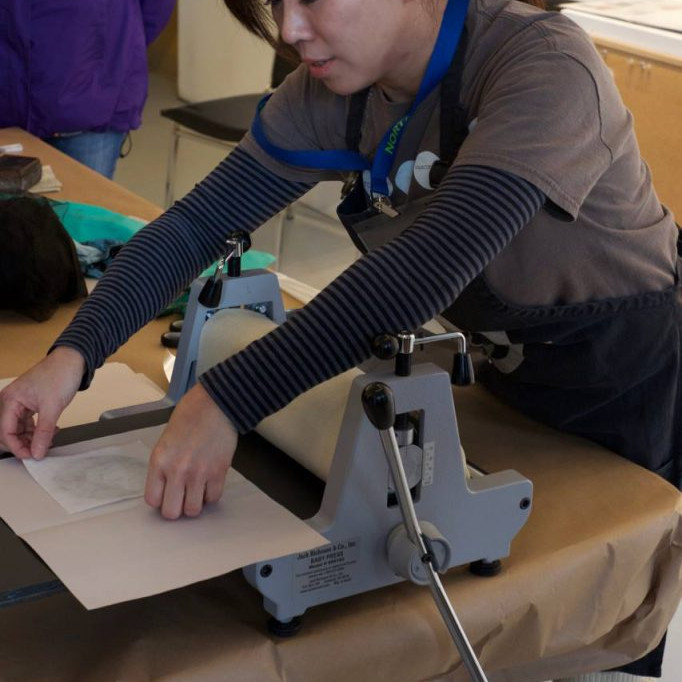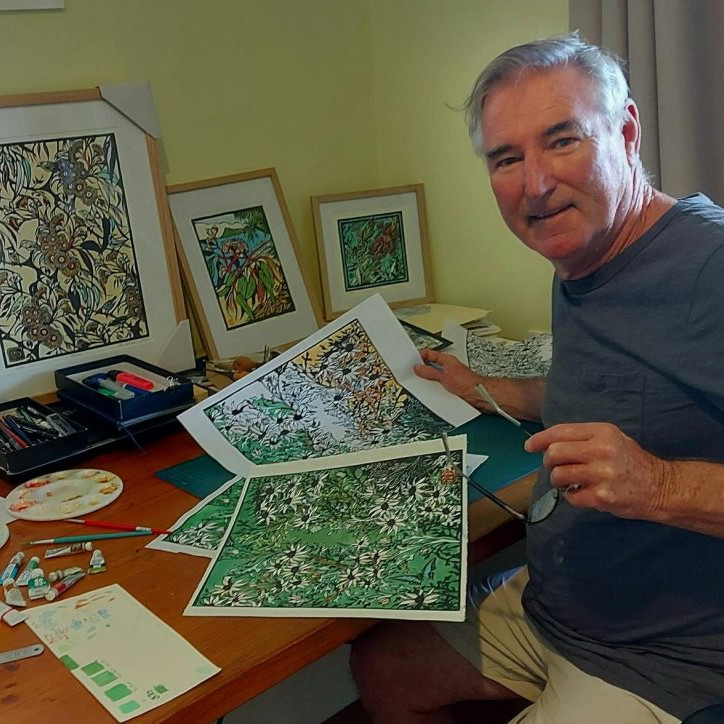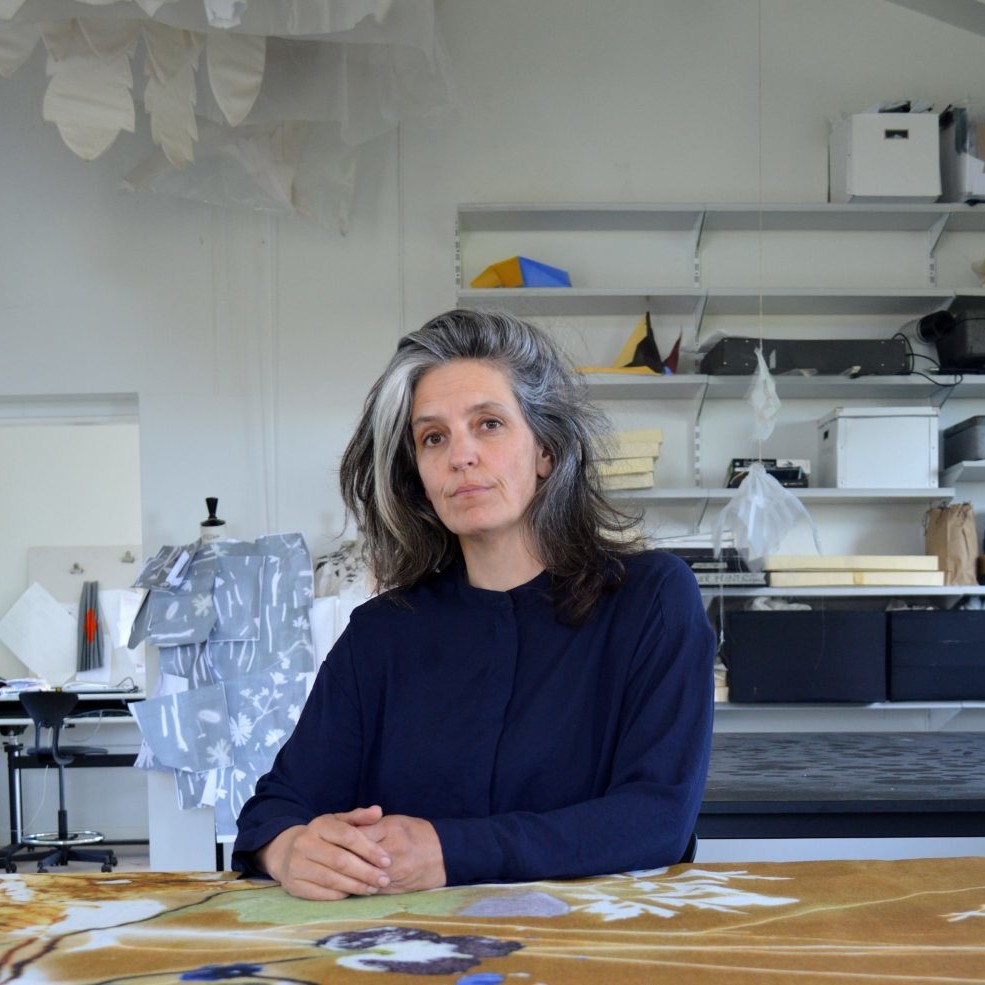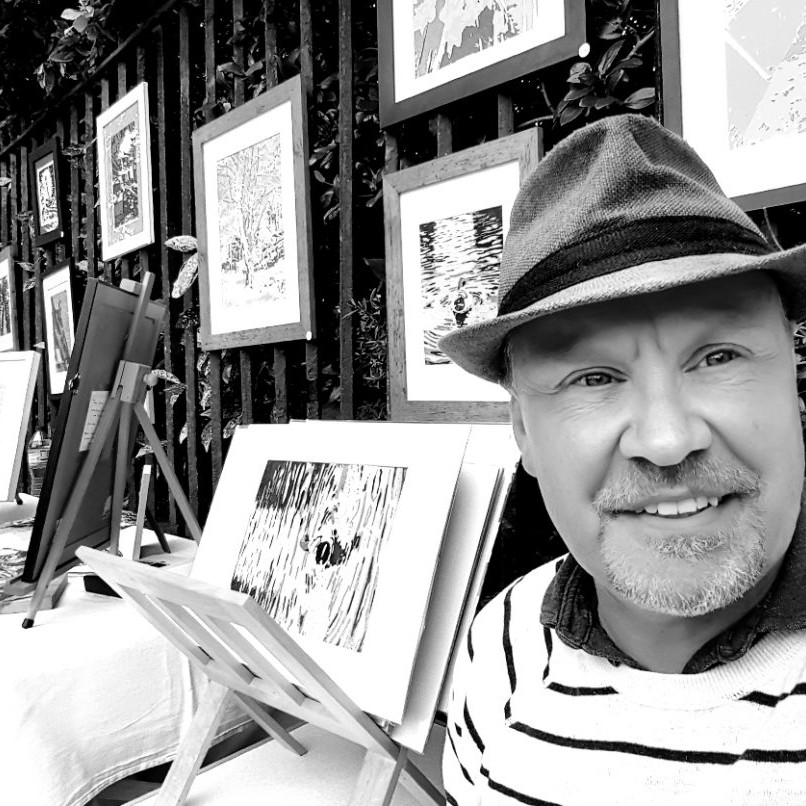Anita Laurence Printmaker - Victoria, Australia.
Explain how your career in art and printmaking began?
I studied Fine Art Painting at Prahran College and when I met my husband printmaker Bill Young I had access and encouragement to make prints. Prints were easy for me to make while I was raising a family, I could work at the kitchen table. Unlike painting which for me was all consuming, making prints fitted in to the routine. Bill and I work together, we share a studio with space for my painting and for the three now four presses. I did not always have a studio. I like to remind people of this especially artists starting out. I made art where and when I could. Bill operates a custom printmaking workshop, so I have always had access to a press. I was once given the book Significant Others and I feel Bill and I fit that title – we work together, supporting each other in what we do. Over the years I have helped in many ways from paper prep to wiping plates. Bill does the majority of my editioning the exception being my reduction prints which I print myself. Bill also makes my frames from reclaimed timbers some from local trees and more recently from Kauri Pine floor boards .
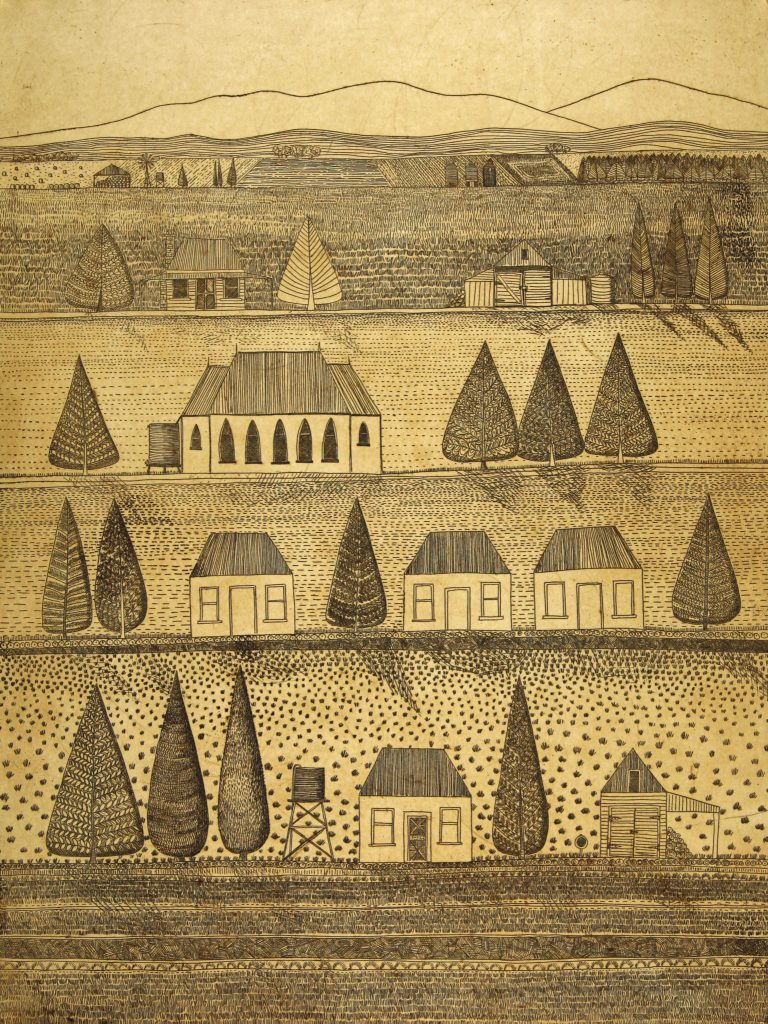
Our Place, 56 x 76 cm, Etching
You live in country Victoria, Australia how does the environment effect your work?
I paint and make prints about my locality, it is my inspiration. I live in the very beautiful King Valley in North East Victoria. The landscape is ever changing with the time of day and the seasons. I have lived here for 30 years and I am still inspired by my surrounds – each season is different, and the colours inform my artwork.
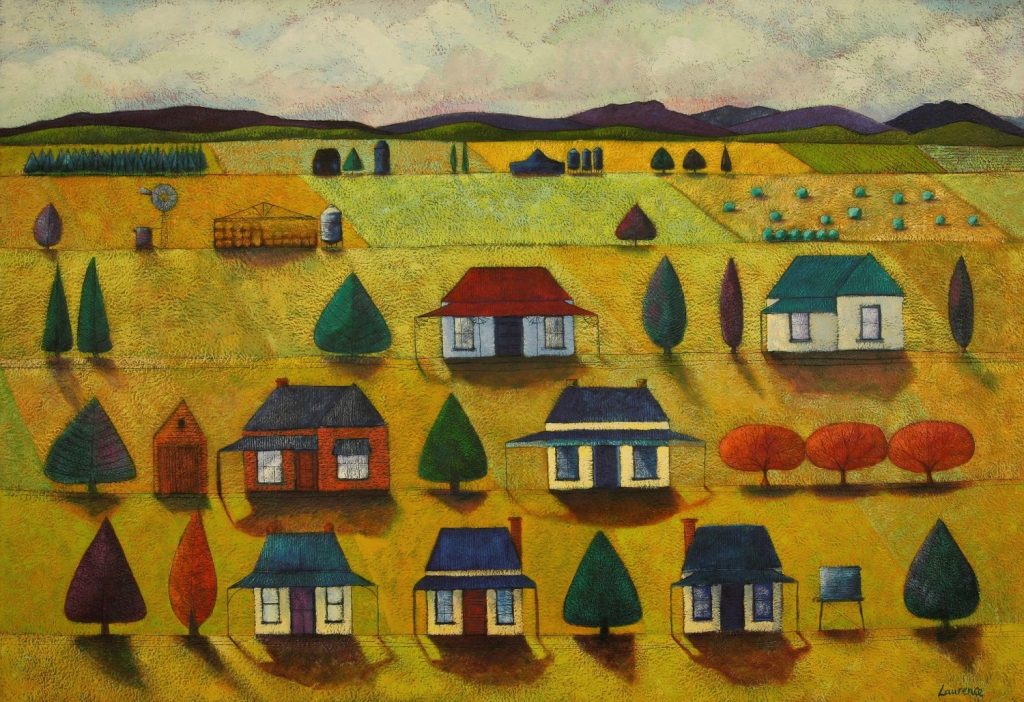 On the Edge of Town, 68 x 99 cm, Acrylic and Ink on Blue Lake cotton paper
On the Edge of Town, 68 x 99 cm, Acrylic and Ink on Blue Lake cotton paper
Discuss your visit to Ireland and one or two works that came from your visit plus the difference from Australia?
Ireland was my first experience of visiting another country. In 2008 Bill and I went to stay with friends and family in Cork and spent time at the Cork Printmakers. As with most people the experience of travel and another country is inspiring and eye opening.
The linocut ‘Corcaigh’, the Irish name for Cork City, was made later when I was artist in residence at The Art Vault in Mildura. It was quite incongruous to be in hot Mildura and creating images of wintry Cork City. Like most of my images they are stylised and representative, based on memories and my feeling for a place. I will make sketches and take photos but I prefer to let my imagination inform the image making.
My King Valley images are stylised layered landscapes – with iconic trees and buildings, rivers in the foreground and hills and mountains in the background. My visit to Cork City had me thinking about how best to represent a city, it’s my memory of walking the steep and winding streets, lanes and alleys from where I was staying in Turner’s Cross.
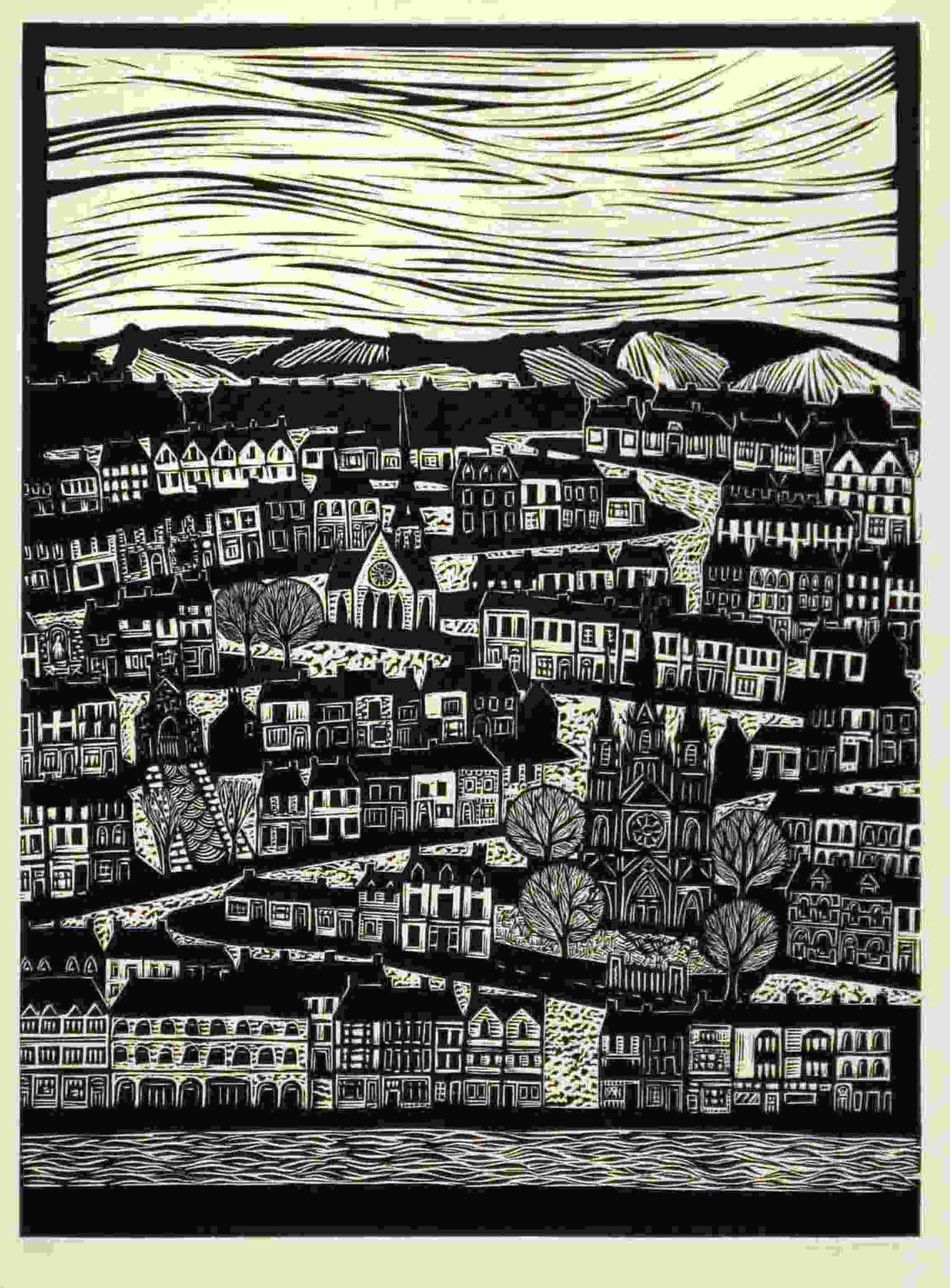
Corcaigh (2009) 56 x 42 cm, linocut
Expand on the importance of having your early prints, printed by Port Jackson Press?
In 1985 David Rankin, owner of Port Jackson Press was working with Bill in the Middle Park studio when he noticed the relief etching cards I was making, he was taken by them and invited me to produce some limited edition prints. Having an outlet for my work, meant that I was productive in my art practise while raising a young family, an important esteem building time for me. Through PJP and then Chrysalis Publishing my work was distribute to galleries all over Australia, exposing my work to a greater audience and being purchased for the collections of The Parliament House Art Collection, Canberra; National Australia Bank and the Peter MacCallum Cancer Centre collections to name a few. I had this outlet till about 1998.
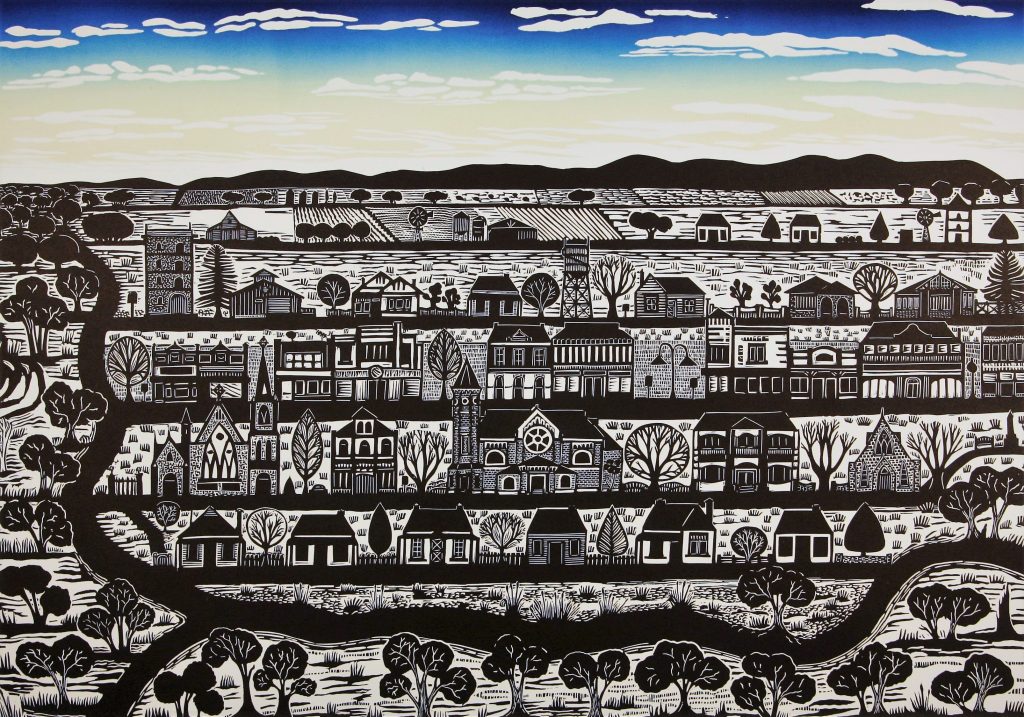 Under a Blue Sky, 60 x 80cm, linocut
Under a Blue Sky, 60 x 80cm, linocut
Country art galleries have supported your work. Discuss the importance of country and regional galleries to both the artist and residents?
Country and regional galleries offer opportunities for local artists to get involved exhibit their work. I have been represented by The Muse Gallery of Milawa since 2004 till 2016 when it closed and The Art Vault in Mildura since 2009. A new gallery Off Centre Gallery + Studio opened in Milawa which means my artwork is still represented in the region. The Muse Gallery and now Off Centre showcase local contemporary art giving the community an opportunity to see and support their local artists. The gallery is situated in a tourist hub giving visitors an enriching experience of seeing artworks they might not see in the cities, artworks relevant to the region.
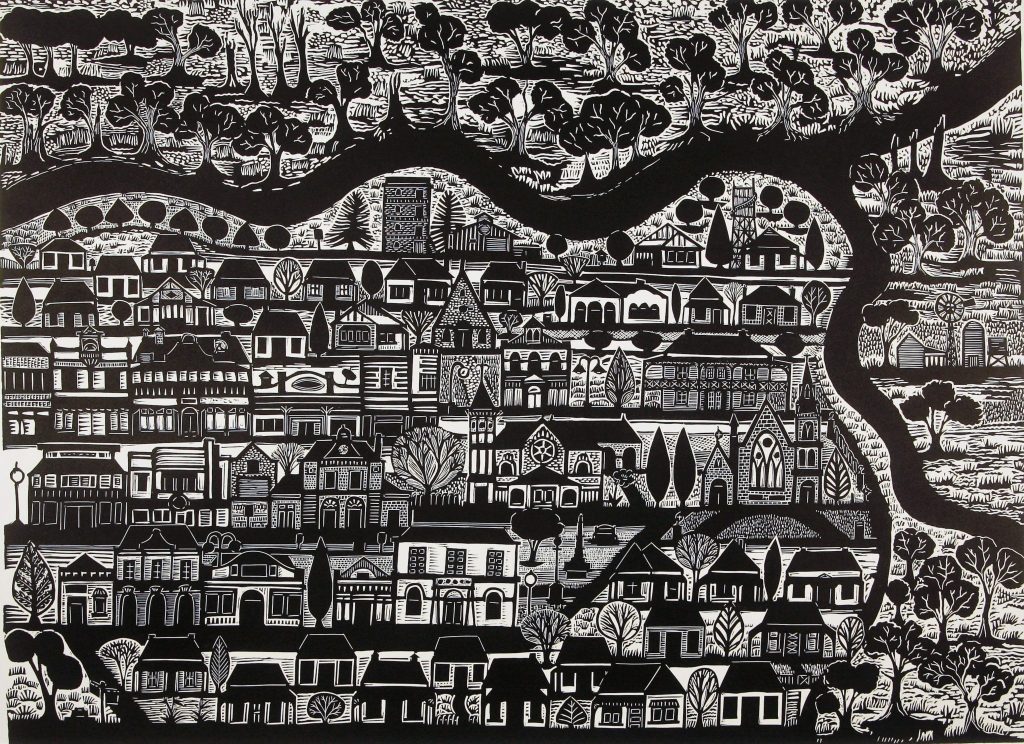 Where the Rivers Meet, 56 x 76 cm, linocut
Where the Rivers Meet, 56 x 76 cm, linocut
It’s an honour to exhibit my work in my community. Not only am I supported by the gallery I am supported by the people of the region who come and purchase my artworks for themselves and as gifts to send further a field. I love it when people comment that my artworks makes them see their landscape afresh, seeing things in it they hadn’t noticed before. Or that they recognise my buildings or trees in the landscape, and that those trees do really exist! I think a lot of local people feel a sense of pride in seeing their region and home in my work.
Regional and country galleries showcase that the arts are alive and well away from the city centres.
I live in a community that values its artists and the role they play in the enriching the community. I have been involved the King Valley Art Show for nearly 20 years and the growth and appreciation of this show from the local businesses and the community is quite astounding. Each year we have been able to offer 17 awards to the value of $17,000 and though it might not sound like a big amount in some circles it is a token of how the arts are valued.
Often country galleries give the viewer a chance to see work that isn’t shown in the city. I love that these galleries make art accessible to all. I have found this especially so at The Art Vault where anyone who walks in is treated with respect and encouraged to enjoy what is on offer. A place that is inclusive and tries to demystify and educate about the process of printmaking.
I exhibit at other Victorian country galleries, Lauriston Press in Kyneton, Queenscliff Gallery and Workshop and Cascade Art in Maldon.
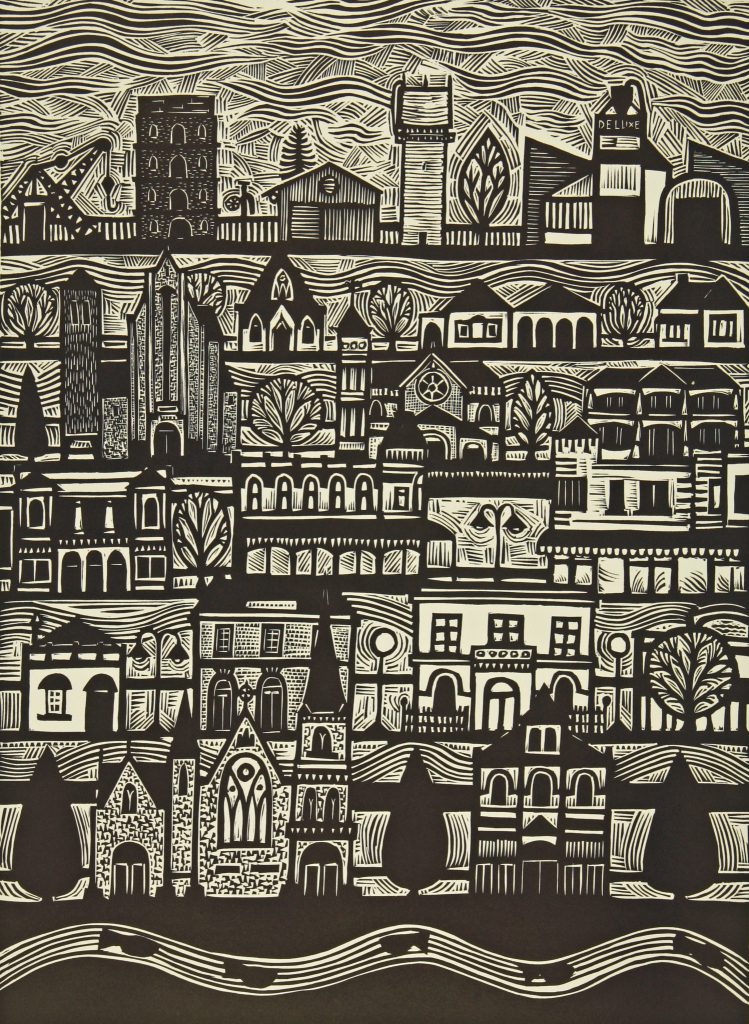
Wangajazzaratta, 52 x 42 cm, Linocut
Wangaratta Art Gallery is my nearest regional gallery (which is a public gallery) and over the years has offered me opportunities to be part of themed group exhibitions- and was instrumental in putting me in contact with other artists thus enabling me to become part of arts groups in my region.
When I travel around the country the first place check out is it’s regional gallery, and I love it when they are exhibiting work of locals and of the locality.
Discuss your work ‘Our Town’ linocut in relation to your printing technique?
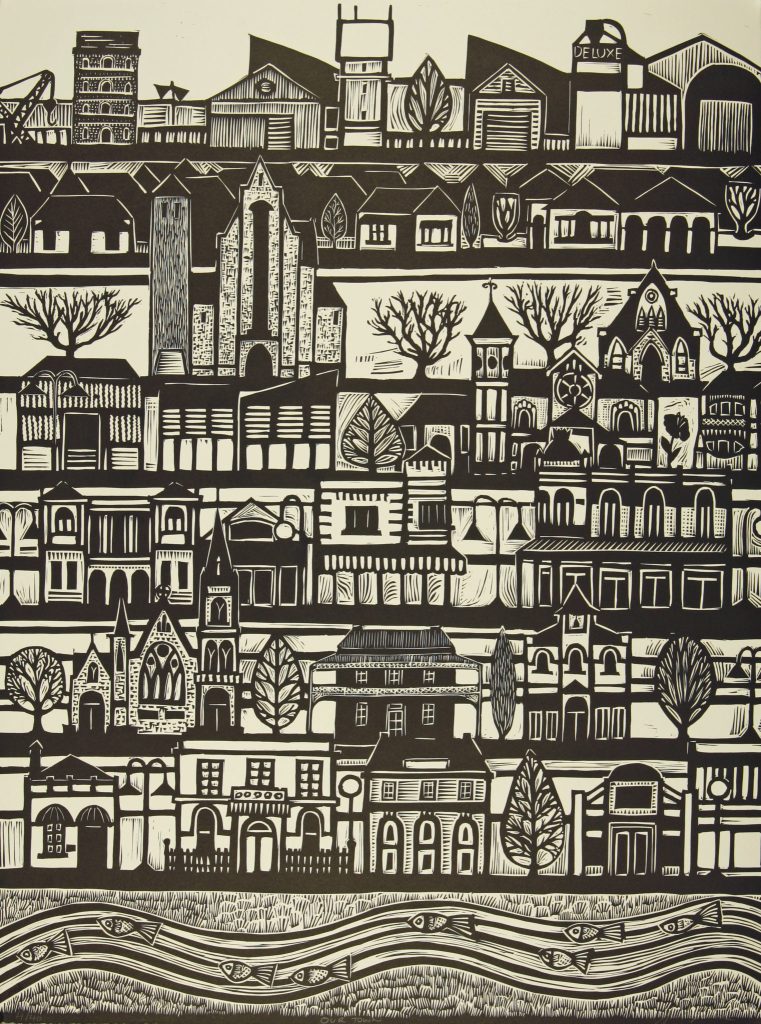
Our Town, 76 x 56 cm, Linocut
Having made paintings and prints about my rural landscape and the cityscapes of places I’d visited as Artist in Residence, lead me back to Wangaratta my own rural city. In 2014 I was invited by Wangaratta Art Gallery to make an artwork to celebrate the 25th Wangaratta Jazz and Blues Festival. I realised that it’s easy to be in awe of a new city or landscape and that I should look with fresh eyes at a place I was so familiar with and perhaps took for granted. Wangaratta had lost a lot of its historical buildings to ‘progress’, and was not as aesthetically beautiful as near by historic Beechworth. When I took the time to look I found the old buildings in amongst the new and that there were many iconic buildings still standing strong within the town. I took the time to investigate the town’s history much like I did in Mildura when on residency. ‘Our Town’ and ‘Wangajazzaratta’ were the result. I have gone on to make more prints about Wangaratta. ‘Under a Blue Sky’ and ‘Where the Rivers Meet’ are two such linocuts.
Expand on the use of colour or limited colour in your printmaking?
My linocuts of recent years have been mainly black and white, I like the contrast and strength of the black and white. It is also very immediate for me, I have made multi block and reduction prints in the past which I loved making but find I am impatient and have been happy to work in black and white. My paintings are very colourful and compensate for lack of colour in my linocuts, saying that I have made some reduction linocuts, more recently, these colour prints are more personal and private and tend to stay in the drawers. I was inspired by the Japanese printmaker Hokusai to add colour back into my skies. Powlett River a very limited edition multi block print I made in 1996 is still one of my favourite works it is full of rolled blended colours, looking at it now it’s sky was probably inspired by Japanese prints.
 Powlett River, 38 x 128 cm Triptich, Multi-Block, colour, Linocut
Powlett River, 38 x 128 cm Triptich, Multi-Block, colour, Linocut
Your ‘Millewa Series’ discuss the two different mediums you have use together in this one exhibition.
The Millewa series was made after one of my residencies at The Art Vault in Mildura. I was invited to visit a wheat farm 70 km south of Mildura – driving through the landscape past majestic wheat silos standing tall against the sky, I was intrigued by the arid natural beauty of the landscape, with Mallee trees and vast red soil. I wondered how a wheat crop could grow. From shared stories I began to get a feel of the place and I tried to envisage a way to show the landscape which was so different from the lush green rolling hills and valleys of where I lived in. The black and white prints are about shape and pattern in the landscape- the farmer in a tractor that has driven over every inch of the land for fifty years in all seasons, it was an insight to their special bond to the land. I also created paintings of the landscape enjoying the use of rich reds, oranges and pinks and sage green/grey of the landscape and the expanse of vivid sky blue. I paint on a handmade paper and incise lines and scumble paint over the top of a colourful ink base to create a luminous effect.
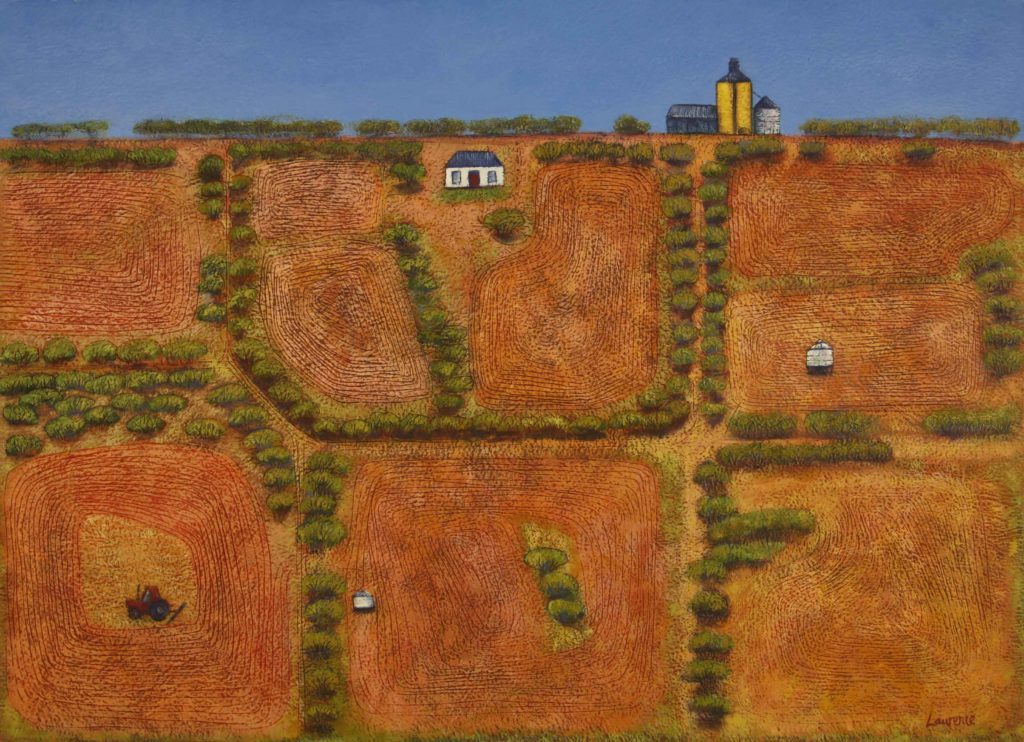 The Millewa, 56 x 76 cm, Arylic and ink on Blue Lake cotton paper
The Millewa, 56 x 76 cm, Arylic and ink on Blue Lake cotton paper
With your limited editions discuss the numbers you print and your protocol at the end of a print run.
When my prints were published by Port Jackson Press and Chrysalis Publishing the edition size was dictated by the publishing house, most often 60. My self published linocuts are editions of 40 and my etchings 15 or 20. We don’t print the complete edition, we print in batches as required. I’d need another storage space if we did (not to mention a bank loan in paper costs). I don’t follow the protocol of cancelling a plate or block at the end of a print run. I hate the idea of disfiguring a block or plate that I have spent hours making, it seems a shocking desecration. If an image is popular I would not hesitate to do a second edition and name it as such.
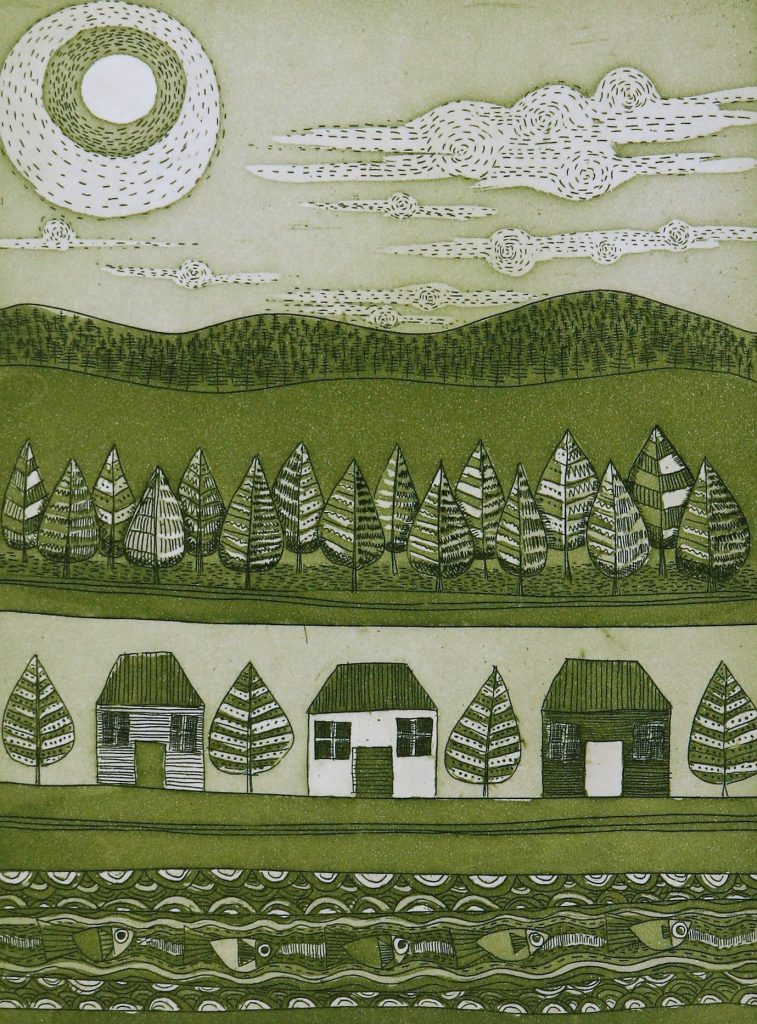 The Valley 1, 20 x 15 cm, Etching Aquatint
The Valley 1, 20 x 15 cm, Etching Aquatint
Contact details:
Anita Laurence
Anita Laurence,Victoria, Australia
Interview by Deborah Blakeley, June 2018
Think a colleague or friend could benefit from this interview?
Knowledge is one of the biggest assets in any business. So why not forward this on to your friends and colleagues so they too can start taking advantage of the insightful information the artist has given?
Other artists you may be interested in:



